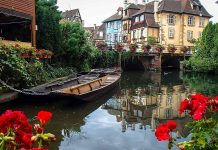
Historic European Cafés: Where Coffee Meets Centuries of Culture
Europe’s café culture is more than just a place to sip espresso—it’s a living museum of history, art, and intellectual exchange. From Vienna’s grand coffee houses to Paris’s bohemian literary haunts, these historic cafés have witnessed revolutions, inspired masterpieces, and hosted legendary thinkers. Join us on a journey through Europe’s most iconic cafés, where every cup tells a story.
1. Café Central – Vienna, Austria
Established: 1876
No list of historic European cafés is complete without Vienna’s Café Central. With its soaring arched ceilings, marble columns, and gilded chandeliers, this café was once the meeting place for intellectuals like Sigmund Freud, Leon Trotsky, and writer Peter Altenberg.
Why Visit?
- Try the Wiener Melange, Vienna’s signature coffee blend.
- Indulge in Apfelstrudel or Sachertorte while soaking in the imperial ambiance.
- Admire the grand neo-Renaissance architecture that has remained unchanged for over a century.
2. Café de Flore – Paris, France
Established: 1887
A cornerstone of Parisian intellectual life, Café de Flore was the preferred haunt of existentialist philosophers Jean-Paul Sartre and Simone de Beauvoir, who wrote here daily. Pablo Picasso and Ernest Hemingway also frequented this iconic Left Bank café.
Why Visit?
- Order a café crème and people-watch from the classic red booths.
- Enjoy the timeless Art Deco interior that has inspired generations.
- Stroll through Saint-Germain-des-Prés, one of Paris’s most literary neighborhoods.
3. Caffè Florian – Venice, Italy
Established: 1720
Holding the title of Italy’s oldest café, Caffè Florian sits proudly in Venice’s Piazza San Marco. Over the centuries, it has hosted Casanova, Lord Byron, and Charles Dickens, who all enjoyed coffee under its frescoed ceilings.
Why Visit?
- Sip an espresso while listening to live classical music in the square.
- Marvel at the opulent 18th-century interiors with gold leaf and Venetian mirrors.
- Try the cioccolata calda (thick Italian hot chocolate) for a decadent treat.
4. Café A Brasileira – Lisbon, Portugal
Established: 1905
Famous for its association with Portuguese poet Fernando Pessoa, Café A Brasileira is a Lisbon landmark. The bronze statue of Pessoa sitting at an outdoor table invites visitors to join the literary legacy.
Why Visit?
- Taste the bica (Portugal’s strong espresso) paired with a pastel de nata.
- Admire the Art Nouveau décor, including the original 1905 counter.
- Explore the bohemian Chiado district, a hub for artists and writers.
5. Café New York – Budapest, Hungary
Established: 1894
Once the meeting place for Budapest’s literary elite, Café New York is a masterpiece of Belle Époque grandeur. With its crystal chandeliers, gilded ceilings, and mirrored walls, it’s often called “the most beautiful café in the world.”
Why Visit?
- Try Hungarian coffee specialties like kávé with a slice of Dobos torte.
- Admire the frescoes and statues that evoke Budapest’s golden age.
- Experience live piano music in the evenings.
6. Antico Caffè Greco – Rome, Italy
Established: 1760
Rome’s oldest café, Antico Caffè Greco, has welcomed artists like Goethe, Liszt, and Keats. Its velvet-lined walls and antique paintings transport visitors back to the Romantic era.
Why Visit?
- Order a cappuccino or marocchino (espresso with cocoa).
- Browse the historic portraits and memorabilia of famous patrons.
- Step outside to explore Rome’s luxury shopping street, Via dei Condotti.
7. Café Imperial – Prague, Czech Republic
Established: 1914
A stunning example of Art Deco design, Café Imperial was a favorite of Franz Kafka. Its intricate ceramic mosaics and stained glass evoke early 20th-century elegance.
Why Visit?
- Savor a Viennese-style coffee with traditional Czech pastries.
- Admire the detailed tilework that covers the walls and ceilings.
- Enjoy a quiet retreat from Prague’s bustling Old Town.
Conclusion: A Sip of History
Europe’s historic cafés are more than just places to drink coffee—they are time capsules of culture, art, and philosophy. Whether you’re drawn to Vienna’s imperial grandeur, Paris’s literary legacy, or Venice’s romantic charm, each café offers a unique glimpse into the past. So next time you’re in Europe, skip the chain coffee shops and step into a living piece of history.
Which of these legendary cafés would you visit first? Let us know in the comments! ☕





















